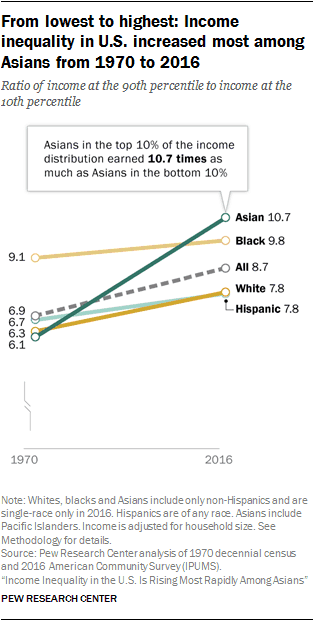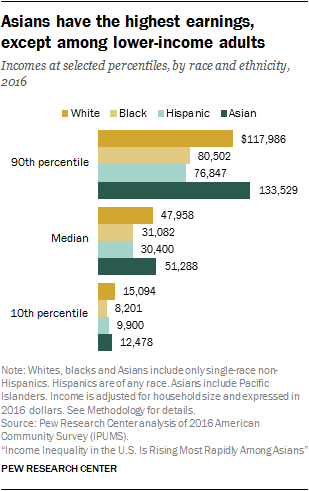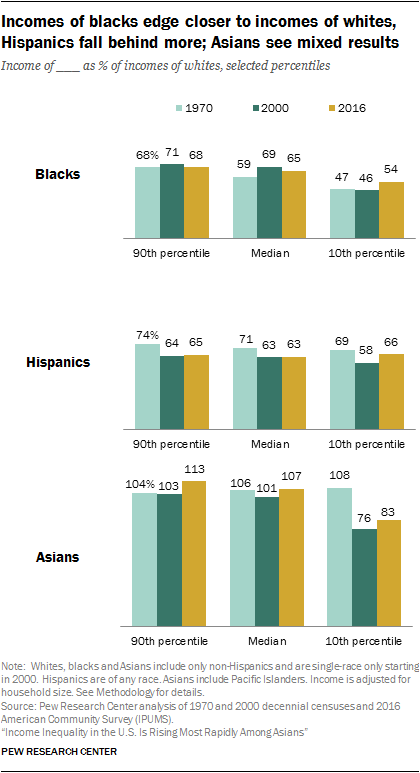Income Inequality in the U.S. Is Rising Most Rapidly Among Asians
Rakesh Kochhar and Anthony Cilluffo, Pew Research Center, July 12, 2018
{snip}
Today, income inequality in the U.S. is greatest among Asians. From 1970 to 2016, the gap in the standard of living between Asians near the top and the bottom of the income ladder nearly doubled, and the distribution of income among Asians transformed from being one of the most equal to being the most unequal among America’s major racial and ethnic groups.
In this process, Asians displaced blacks as the most economically divided racial or ethnic group in the U.S., according to a new Pew Research Center analysis of government data. {snip}

{snip}
The income gap between Americans at the top and the bottom of the income distribution widened 27% from 1970 to 2016. Among all Americans, those near the top of the income ladder had 8.7 times as much income as those near the bottom in 2016, $109,578 compared with $12,523. In 1970, Americans near the top had 6.9 times as much income as those near the bottom, $63,512 compared with $9,212. (All income estimates are adjusted for household size and expressed in 2016 dollars.)
This measure of inequality, known as the 90/10 ratio, takes the ratio of the income needed to place among the top 10% of earners in the U.S. (the 90th percentile) to the income at the threshold of the bottom 10% of earners (the 10th percentile).1 {snip}
The 90/10 ratio varies widely by race and ethnicity. In 2016, Asians at the 90th percentile of their income distribution had 10.7 times the income of Asians at the 10th percentile. The 90/10 ratio among Asians was notably greater than the ratio among blacks (9.8), whites (7.8) and Hispanics (7.8).
{snip}
The standard of living of lower-income Asians stagnated from 1970 to 2016
{snip}
Whites, blacks and Hispanics at the 90th percentile also experienced relatively large gains in income (80%, 79% and 58% respectively). {snip}
The trends in income growth also show that blacks made some progress in closing the gap with whites. Blacks at the median and at the 10th percentile experienced more of an increase in income than similarly situated whites, and blacks at the 90th percentile kept pace with whites.10 Hispanics experienced smaller increases in income than whites at all percentiles, however. Thus, lower-, middle- and upper-income Hispanics all lost ground to their white counterparts from 1970 to 2016.
As it has with Asians, immigration has been an important part of the Hispanic experience in recent decades. In 2016, 47% of adult Hispanics were foreign born, up from 34% in 1970. {snip}
{snip}
Income inequality and income gaps: Two windows into the well-being of racial and ethnic groups
{snip} The fact that inequality increased within each racial and ethnic group shows that no community was immune to the factors said to have raised U.S. inequality since 1970. These factors include technological change, globalization, the decline of unions and the eroding value of the minimum wage.
At the same time, the drivers of income inequality appear to have had a disproportionate impact on some racial and ethnic groups, as evidenced by the differences in the level of inequality and the degree to which it increased for each group. That could be because of differences in the characteristics of workers, such as educational attainment (greater among Asians and whites) and the share foreign born (greater among Asians and Hispanics). Also, larger societal forces may have affected some groups more than others, such as the disparately high rate of incarceration among black men (see text box).
The aforementioned differences in worker characteristics also contribute to the gaps in incomes across racial and ethnic groups. In addition, the historical legacy and current impact of discrimination are considered to be important factors in these gaps. {snip}
It is worth noting that overall income inequality in the U.S. would persist even if the gaps in income across racial and ethnic groups were eliminated. For example, suppose that blacks, Hispanics and Asians had the same income distribution as whites. In that case, everyone at any given rung of the income ladder – lower, middle or upper – would have the same income regardless of race or ethnicity. However, the 90/10 ratio for the U.S. would fall only from 8.7, its actual level, to 7.8, the level that currently prevails among whites.14
Conversely, easing income inequality within racial and ethnic groups may have little impact on the gaps across groups. Suppose that incomes at the lower rungs of the ladder are raised 10% and incomes at the top are reduced 10%. This would reduce inequality overall and within each group, but the gaps in income across groups would be unchanged.
Inequality in the U.S. is higher than in other advanced economies
U.S., and the fact that it is comparable with the levels that existed in the 1920s by at least one measure, is of concern to many. Then-Federal Reserve Chair Janet Yellen remarked in 2014, “The extent of and continuing increase in inequality in the United States greatly concern me.” But others are more sanguine, arguing that the trends in U.S. inequality do not constrain opportunities for those at the bottom of the income distribution.
In the midst of this debate, it is worth noting that income inequality in the U.S. is higher than among other advanced economies and has also increased more rapidly in recent decades. Cross-national comparisons of income inequality are often based on the Gini coefficient, a widely used measure of inequality (see text box). The Gini coefficient in the U.S. stood at 0.435 in 2016 (based on gross income and on a scale of 0 to 1), according to the Organization for Economic Cooperation and Development (OECD).15 This was the highest of any of the G-7 countries, which ranged from 0.330 in France to 0.388 in the UK.
Indeed, OECD estimates show that the Gini coefficient for the U.S. is closer to the Gini for India (0.495) than to most of the G-7 countries. The level of inequality in the U.S. is also higher than the level of inequality in other OCED countries, with the exceptions of Chile, Mexico and Turkey.16 Globally, inequality is highest in countries in southern Africa (Gini coefficients of about 0.6) and lowest in eastern Europe and parts of northern Europe (Gini coefficients of about 0.25), according to World Bank estimates.

From 1970 to 2016, income growth skews to the top, more so among Asians
{snip}
The pattern observed nationally is also present among whites, blacks, Hispanics and Asians, but to varying degrees. Whites at the 90th percentile of their income distribution earned $117,986 in 2016. Meanwhile, the median income for whites was $47,958 and their income at the 10th percentile was $15,094. From 1970 to 2016, the 90th percentile income for whites increased 80%, notably greater than the increase of 52% at the median and an increase of 45% at the 10th percentile.
Changes in income at the various points of the income distribution were somewhat more balanced among blacks. For blacks, the income at the 90th percentile was $80,502 in 2016, compared with $31,082 at the median and $8,201 at the 10th percentile. Compared with 1970, these income levels represented an increase of 79% at the 90th percentile, 66% at the median, and 67% at the 10th percentile.
Income growth for Hispanics lagged behind the growth for other racial and ethnic groups at most points of the income distribution. In 2016, Hispanics at the 90th percentile earned $76,847, some 58% more than in 1970. The income of Hispanics at the median stood at $30,400 in 2016, up 36% from 1970. Meanwhile, Hispanics at the 10th percentile earned $9,900 in 2016, 37% higher than in 1970. {snip}
{snip}
Following a rapid increase from 1970 to 2016, income inequality is highest among Asians
{snip}
Blacks experienced the highest level of income inequality in 1970, and through most of the period examined. In 1970, the 90/10 ratio for blacks stood at 9.1, well above the ratios for the other groups. But after peaking around 10 in 1990, the 90/10 ratio for blacks edged down to 9.8 in 2016. Over the period from 1970 to 2016, income inequality among blacks increased only 7% by this measure. That was the smallest increase in inequality among the major racial and ethnic groups.
The increase in inequality among whites and Hispanics was greater than among blacks. For whites, the 90/10 ratio increased from 6.3 in 1970 to 7.8 in 2016, a 24% increase. The 90/10 ratio for Hispanics increased from 6.7 in 1970 to 7.8 in 2016 (15%). Despite the increase, whites and Hispanics had the lowest levels of income inequality in 2016.
{snip}
Income gaps across racial and ethnic groups persist and, in some cases, are wider than in 1970
America’s major racial and ethnic groups are divided into two distinct income brackets. Whites and Asians are in the bracket at the top and blacks and Hispanics, with incomes largely comparable with each other, are in the bracket below. The gaps between the two brackets are sizable and the shifts since 1970, with few exceptions, have been modest.
Whites and Asians out-earn blacks and Hispanics at all rungs of the income ladder
In 2016, Asians earned more than other groups at the middle and near the top of the income distribution. Asians at the 90th percentile of their distribution had an income of $133,529, considerably higher than the incomes of 90th percentile whites ($117,986), blacks ($80,502) and Hispanics ($76,847). (Incomes are adjusted for household size and expressed in 2016 dollars.)
The same ranking by income exists at the median (50th percentile). The median income of Asians in 2016 – $51,288 – was higher than the median income of whites ($47,958) and considerably greater than that of blacks ($31,082) and Hispanics ($30,400).
Asians did not hold the same edge over all other groups at the lower rungs, however. {snip}
{snip}
At the median, Hispanics earned more than blacks in 1970, $22,396 compared with $18,719. But this gap eroded over time, and by 2016 the median incomes of Hispanics ($30,400) and blacks ($31,082) were similar. The influx of Hispanic immigrants in recent decades, many with less education, likely played a role in shaping these trends (see below).28
Another notable change from 1970 is in the relative standing of lower-income Asians. In 1970, the 10th percentile income for Asians ($11,270) was similar to the 10th percentile incomes for whites ($10,440). But the income of Asians at this percentile increased just 11% from 1970 to 2016. As a result, whites had the highest income at the 10th percentile in 2016, and lower-income blacks and Hispanics narrowed the gap with lower-income Asians in recent decades.
Blacks inch closer to whites in earnings, Hispanics fall behind more, and Asians see mixed results
{snip}
The gaps in income between whites and blacks are large, but they narrowed slightly from 1970 to 2016. In 1970, blacks at the 90th percentile of their distribution earned 68% as much as whites at the 90th percentile of their distribution. Nearly five decades later, this gap was unchanged in 2016. However, at the median, blacks earned 65% as much as whites in 2016, up from 59% in 1970. Similarly, lower-income blacks narrowed the gap from 47% in 1970 to 54% in 2016.
While the gap between blacks and whites closed a bit from 1970 to 2016, Hispanics fell even further behind, whether at the 10th percentile, the median or the 90th percentile. Near the top, Hispanics earned 65% as much as whites in 2016 compared with 74% in 1970. Near the bottom, the income of Hispanics slipped from 69% of the income of whites in 1970 to 66% in 2016.
Gaps in income across the entirety of the income distribution
A closer look at the gap between whites and other groups across the income distribution reveals the diversity of experiences from 1970 to 2016. The majority of Asians, especially those at the lower rungs of the income ladder, ceded ground to whites from 1970 to 2000, but all experienced a rebound to some extent this century. Hispanics, regardless of where they were in the income distribution, fell behind from 1970 to 2000, but lower-income Hispanics recovered some ground from 2000 to 2016. Among blacks, some of the gains from 1970 to 2000 were erased since 2000.
{snip}
Most blacks, with the exception of those at the 95th percentile, saw gains relative to whites from 1970 to 2016. But there were two distinct episodes in this period, with gains from 1970 to 2000 followed by setbacks from 2000 to 2016. For example, the median income of blacks increased from 59% as much as the median income of whites in 1970 to 69% as much in 2000. But the median for blacks decreased to 65% of the median for whites in 2016. A similar regression describes the experience of most blacks with incomes above the 25th percentile of the income distribution from 1970 to 2016.
The reversal for blacks this century may reflect the impact of the Great Recession of 2007-09. Although no group was immune to the effects of the recession, the unemployment rate for blacks spiked to a high of 16.8% in March 2010, meaning one-in-six blacks in the workforce did not have a job. Also, the employment of blacks dipped below its potential (what it might have been absent a recession) more so than among whites during the Great Recession.
It is worth noting that the economic downturns this century came on the heels of a record-long expansion in the 1990s that yielded noticeable benefits for blacks. The unemployment rate for blacks dropped to a then-historic low of 7% in April 2000, narrowing the gap in unemployment with respect to whites. Meanwhile, the median household income for blacks, as reported by the Census Bureau, increased by 24% from 1990 to 2000, compared with a gain of 12% for whites.
For Hispanics, incomes sagged in comparison with whites at all points of the distribution from 1970 to 2000. The slippage was almost uniformly high across the distribution, near 10 percentage points whether at the 5th percentile, the median or the 95th percentile. There was little change from 2000 to 2016, with the notable exception of gains for lower-income Hispanics. While they continue to earn much less than their white counterparts, Hispanics at the lowest percentiles of the income distribution experienced an improvement in their relative position from 2000 to 2016.
Immigration helped shape the Hispanic experience from 1970 to 2016
The regression in the economic status of Hispanics relative to whites may be driven by the characteristics of immigrants in recent decades. Immigration accounted for 50% of the total increase in the Hispanic adult population from 1970 to 2016, and the share of the Hispanic population that is foreign born increased from 34% to 47% during the period.29
{snip}

{snip} Hispanic immigrants streamed into the lower rungs of the income ladder at a faster rate than into the higher rungs. From 1970 to 2016, the foreign-born population among the bottom 10% of earners in the Hispanic income distribution increased tenfold, compared with a fivefold increase in the foreign-born population among the top 10% of earners.30
Another characteristic of the Hispanic foreign-born population is the sharp rise in the number of unauthorized immigrants in recent decades. From 1990 to 2015, the Hispanic foreign-born population (all ages) increased from 7.8 million to 19.4 million, by 11.6 million. Meanwhile, from 1990 to 2014, the number of unauthorized immigrants in the U.S. who arrived from Latin America increased from an estimated 3.0 million to 8.6 million, by 5.6 million.31 Thus, unauthorized migration accounts for almost half of the increase in the Hispanic foreign-born population since 1990.
The increase in the unauthorized immigrant population from Latin America leveled off in 2007, however. In 2007, there were 9.8 million unauthorized immigrants from Latin America in the U.S., compared with 8.6 million in 2014, the latest available estimate. The decrease in new arrivals meant that unauthorized immigrants increasingly are likely to have been in the U.S. for 10 years or more – 66% in 2014, compared with 41% in 2005.32
The rapid rise and more recent leveling off of the unauthorized immigrant population may explain some of the change in the economic status of Hispanics relative to whites. Because the earnings of unauthorized immigrants are much lower than average, their initial influx likely dampened the earnings potential of Hispanics, which explains at least some of the widening of the income gap with whites since 1970. More recently, unauthorized immigrants are a declining share of the Hispanic population, and those who remain are longer tenured in the U.S., likely with higher potential earnings. That could help explain some of the improvement in the economic status of lower-income Hispanics relative to whites since 2000.
[Editor’s Note: Notes and additional charts and graphs are available at the original story, where the entire report may be downloaded as a PDF.]















